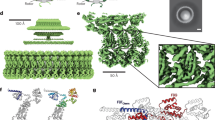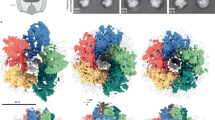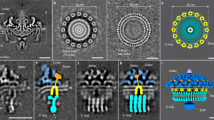Abstract
The bacterial flagellar motor is a rotary molecular machine that rotates the helical filaments that propel many species of swimming bacteria1,2. The rotor is a set of rings up to 45 nm in diameter in the cytoplasmic membrane3; the stator contains about ten torque-generating units anchored to the cell wall at the perimeter of the rotor4,5. The free-energy source for the motor is an inward-directed electrochemical gradient of ions across the cytoplasmic membrane, the protonmotive force or sodium-motive force for H+-driven and Na+-driven motors, respectively. Here we demonstrate a stepping motion of a Na+-driven chimaeric flagellar motor in Escherichia coli6 at low sodium-motive force and with controlled expression of a small number of torque-generating units. We observe 26 steps per revolution, which is consistent with the periodicity of the ring of FliG protein, the proposed site of torque generation on the rotor7,8. Backwards steps despite the absence of the flagellar switching protein CheY indicate a small change in free energy per step, similar to that of a single ion transit.
This is a preview of subscription content, access via your institution
Access options
Subscribe to this journal
Receive 51 print issues and online access
$199.00 per year
only $3.90 per issue
Buy this article
- Purchase on Springer Link
- Instant access to full article PDF
Prices may be subject to local taxes which are calculated during checkout




Similar content being viewed by others
References
Berry, R. M. & Armitage, J. P. The bacterial flagella motor. Adv. Microb. Physiol. 41, 291–337 (1999)
Berg, H. C. The rotary motor of bacterial flagella. Annu. Rev. Biochem. 72, 19–54 (2003)
Thomas, D. R., Morgan, D. G. & DeRosier, D. J. Rotational symmetry of the C ring and a mechanism for the flagellar rotary motor. Proc. Natl Acad. Sci. USA 96, 10134–10139 (1999)
Blair, D. F. & Berg, H. C. Restoration of torque in defective flagellar motors. Science 242, 1678–1681 (1988)
Berry, R. M., Turner, L. & Berg, H. C. Mechanical limits of bacterial flagellar motors probed by electrorotation. Biophys. J. 69, 280–286 (1995)
Asai, Y., Yakushi, T., Kawagishi, I. & Homma, M. Ion-coupling determinants of Na+-driven and H+-driven flagellar motors. J. Mol. Biol. 327, 453–463 (2003)
Suzuki, H., Yonekura, K. & Namba, K. Structure of the rotor of the bacterial flagellar motor revealed by electron cryomicroscopy and single-particle image analysis. J. Mol. Biol. 337, 105–113 (2004)
Lloyd, S. A. & Blair, D. F. Charged residues of the rotor protein FliG essential for torque generation in the flagellar motor of Escherichia coli. J. Mol. Biol. 266, 733–744 (1997)
Mehta, A. D. et al. Myosin-V is a processive actin-based motor. Nature 400, 590–593 (1999)
Schnitzer, M. J. & Block, S. M. Kinesin hydrolyses one ATP per 8-nm step. Nature 388, 386–390 (1997)
Yasuda, R., Noji, H., Kinosita, K. Jr & Yoshida, M. F1-ATPase is a highly efficient molecular motor that rotates with discrete 120 degree steps. Cell 93, 1117–1124 (1998)
Diez, M. et al. Proton-powered subunit rotation in single membrane-bound FOF1-ATP synthase. Nature Struct. Mol. Biol. 11, 135–141 (2004)
Berg, H. C. in Cell Motility Vol. A (eds Goldman, R., Pollard, T. & Rosenbaum, J.) 47–56 (Cold Spring Harbor Press, New York, 1976)
Berg, H. C. & Turner, L. Torque generated by the flagellar motor of Escherichia coli. Biophys. J. 65, 2201–2216 (1993)
Sowa, Y., Hotta, H., Homma, M. & Ishijima, A. Torque-speed relationship of the Na+-driven flagellar motor of Vibrio alginolyticus. J. Mol. Biol. 327, 1043–1051 (2003)
Ryu, W. S., Berry, R. M. & Berg, H. C. Torque-generating units of the flagellar motor of Escherichia coli have a high duty ratio. Nature 403, 444–447 (2000)
Yorimitsu, T. & Homma, M. Na+-driven flagellar motor of Vibrio. Biochim. Biophys. Acta 1505, 82–93 (2001)
Yasuda, R., Noji, H., Yoshida, M., Kinosita, K. Jr & Itoh, H. Resolution of distinct rotational substeps by submillisecond kinetic analysis of F1-ATPase. Nature 410, 898–904 (2001)
Liu, J. Z., Dapice, M. & Khan, S. Ion selectivity of the Vibrio alginolyticus flagellar motor. J. Bacteriol. 172, 5236–5244 (1990)
Fung, D. C. & Berg, H. C. Powering the flagellar motor of Escherichia coli with an external voltage source. Nature 375, 809–812 (1995)
Armitage, J. P. & Evans, M. C. Control of the protonmotive force in Rhodopseudomonas sphaeroides in the light and dark and its effect on the initiation of flagellar rotation. Biochim. Biophys. Acta 806, 42–55 (1985)
Neuman, K. C., Chadd, E. H., Liou, G. F., Bergman, K. & Block, S. M. Characterization of photodamage to Escherichia coli in optical traps. Biophys. J. 77, 2856–2863 (1999)
Samatey, F. A. et al. Structure of the bacterial flagellar hook and implication for the molecular universal joint mechanism. Nature 431, 1062–1068 (2004)
Samuel, A. D. & Berg, H. C. Torque-generating units of the bacterial flagellar motor step independently. Biophys. J. 71, 918–923 (1996)
Meister, M., Lowe, G. & Berg, H. C. The proton flux through the bacterial flagellar motor. Cell 49, 643–650 (1987)
Gabel, C. V. & Berg, H. C. The speed of the flagellar rotary motor of Escherichia coli varies linearly with protonmotive force. Proc. Natl Acad. Sci. USA 100, 8748–8751 (2003)
Scharf, B. E., Fahrner, K. A., Turner, L. & Berg, H. C. Control of direction of flagellar rotation in bacterial chemotaxis. Proc. Natl Acad. Sci. USA 95, 201–206 (1998)
Kuwajima, G. Construction of a minimum-size functional flagellin of Escherichia coli. J. Bacteriol. 170, 3305–3309 (1988)
Datsenko, K. A. & Wanner, B. L. One-step inactivation of chromosomal genes in Escherichia coli K-12 using PCR products. Proc. Natl Acad. Sci. USA 97, 6640–6645 (2000)
Block, S. M., Blair, D. F. & Berg, H. C. Compliance of bacterial flagella measured with optical tweezers. Nature 338, 514–518 (1989)
Acknowledgements
We thank H. Berg and K. Fahrner for the gift of strain HCB1271. The research of R.B., M.L. and A.R. was supported by combined UK research councils through an Interdisciplinary Research Collaboration in Bionanotechnology, that of A.I., M.H. and T.Y. by Grants-in-Aid from the Ministry of Education, Science, Sports, Culture and Technology of Japan, that of M.H. and T.Y. by Soft Nano-Machine Project of JST, and that of Y.S. by JSPS Research Fellowships for Young Scientists. Author Contributions BFP experiments were performed by Y.S. and A.R., fluorescence experiments by A.R. and M.L., experimental design was by R.B., A.I., A.R. and Y.S., data analysis by R.B., Y.S. and A.R., and strain construction by Y.S., T.Y. and M.H. Y.S. and A.R. contributed equally to this work.
Author information
Authors and Affiliations
Corresponding author
Ethics declarations
Competing interests
Reprints and permissions information is available at npg.nature.com/reprintsandpermissions. The authors declare no competing financial interests.
Supplementary information
Supplementary Figure 1
Effect of Na+ concentration on stator number, and initial stator number estimates for step experiments. (DOC 1175 kb)
Supplementary Figure 2
Further examples of stepping rotation. (DOC 1831 kb)
Supplementary Video 1
A 200 nm fluorescent bead rotating at ˜2 Hz, slowed down 40 times. Stepping rotation is visible. (MPG 130 kb)
Rights and permissions
About this article
Cite this article
Sowa, Y., Rowe, A., Leake, M. et al. Direct observation of steps in rotation of the bacterial flagellar motor. Nature 437, 916–919 (2005). https://doi.org/10.1038/nature04003
Received:
Accepted:
Issue Date:
DOI: https://doi.org/10.1038/nature04003
This article is cited by
-
Promising dawn in tumor microenvironment therapy: engineering oral bacteria
International Journal of Oral Science (2024)
-
Dynamic stiffening of the flagellar hook
Nature Communications (2022)
-
Probing nanomotion of single bacteria with graphene drums
Nature Nanotechnology (2022)
-
RETRACTED ARTICLE: Intrinsically unidirectional chemically fuelled rotary molecular motors
Nature (2022)
-
Single-proton torque generation of the bacterial flagellar motor
Journal of the Korean Physical Society (2022)
Comments
By submitting a comment you agree to abide by our Terms and Community Guidelines. If you find something abusive or that does not comply with our terms or guidelines please flag it as inappropriate.



